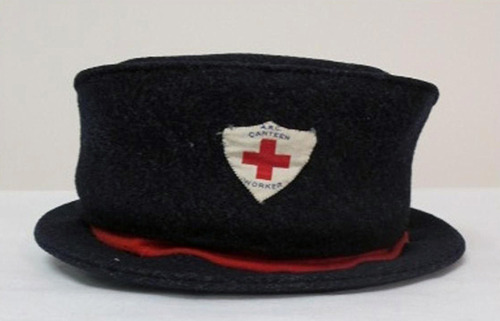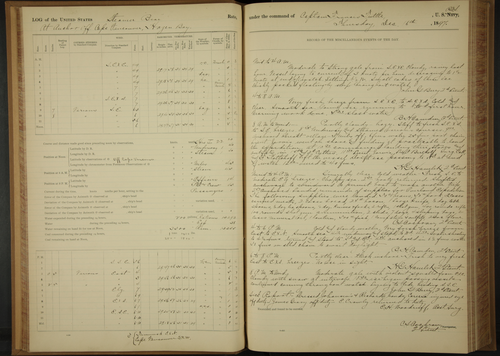
As a Navy veteran I have a particular fondness for U.S. Navy records, especially deck logs. From my first days here at the National Archives when I discovered that we had the actual deck logs from the USS Constitution including her service during the War of 1812 to the day I was handed a deck log of the USS Sanctuary, AH-17 , covering my time aboard that hospital ship in Viet Nam I have been hooked on this record series!
So, it was a real treat to learn that NOAA had approached us in April of 2011 with the idea of digitally imaging the logs of Navy and Coast Guard Revenue Cutter vessels as part of their work with OldWeather.org to document weather conditions in the North Pacific Arctic region during the late 19th and early 20th centuries. In a wonderful crowd sourcing venture, volunteers working with OldWeather.org transcribe handwritten weather observations as well as log entries on vessel movement and activities. It is a win-win cross agency collaboration—NOAA gets the weather data and NARA gets the digital images for posting.
Read the full post on the AOTUS blog.

todaysdocument:
Wright Brothers’ Flying Machine Patent, missing from the National Archives
December 17 is the anniversary of the Wright Brother’s historic first flight in 1903. For most, it’s a day to celebrate a pivotal milestone in aviation history. But here at the National Archives and at other archives, libraries, and museums it’s a reminder of the threat that cultural institutions face on a daily basis. The patent for the Wright Flyer is missing—presumed stolen—last seen in 1979, and it’s not the only item missing.
When such records are stolen —sometimes for resale on web auction sites— our shared history is lost and our ability to maintain accountability in our government is lessened. Together, with your help, we can return our cultural heritage to its rightful place.
For More Information:
via the AOTUS Blog: The Impact of Theft
(Source: research.archives.gov)
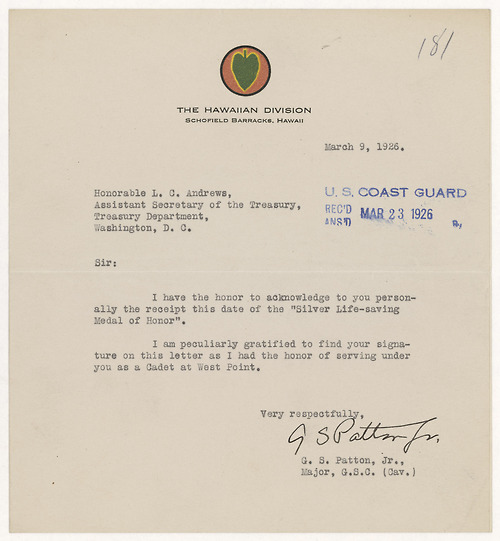
Young George Patton, The Sailor
Growing up in Beverly, Massachusetts I was familiar with the legend of young George Patton rescuing three people whose sailboat had overturned off Beverly Cove. Last week we had a visit from a group of Coast Guard personnel and among the records selected to show them was the file documenting the incident. Imagine my surprise and delight to read the actual evidence. It actually did happen!
The records tell the story from both sides—the rescuers and the rescued.
On August 21, 1923, Major George S. Patton and his wife, Beatrice Ayer Patton were sailing off the coast of Beverly Cove in Beverly, Massachusetts. The weather turned foul, and as they were heading back to shore, they came across three young boys who were stranded in the water after their sailboat had capsized. George and Beatrice Patton rescued the three boys, stowed them in the bottom of their boat to keep them warm, and brought them safely back to land.
Two years later, the Commandant of the Coast Guard, R.E. Day, recommended the award of the silver Life-saving Medal of Honor which Major Patton acknowledged from his Hawaiian duty station.
Read the full post on the AOTUS blog and view the records of the George S. Patton Life-saving Medal file on Flickr.
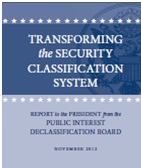
Transforming Classification
The Public Interest Declassification Board (PIDB) at the National Archives has been hard at work this year developing recommendations to the President of the United States to transform the national security classification system.
PIDB is an advisory committee established by Congress to advise and provide recommendations to the President and other executive branch officials on the identification, collection, review for declassification, and release of declassified records of archival value. In addition, PIDB advises the President on policies regarding classification and declassification of national security information.
On Thursday, December 6th, the Public Interest Declassification Board will host an open meeting to discuss its recommendations to the President on Transforming the Security Classification System. The full Report to the President will be published online on December 6th . The meeting will focus on the Board’s fourteen recommendations, centering on the need for new policies for classifying information, new processes for declassifying information, and the imperative for using and integrating technology into these processes.
When: December 6, 2012 from 9:00 a.m. – 10:30 a.m.
Doors Open: 8:45 a.m.
Where: The Archivist’s Reception Room, Room 105 in the National Archives Building
Address: 700 Pennsylvania Avenue, NW, Washington, DC
(Note: Attendees must enter through the Pennsylvania Avenue entrance.)
RSVP: pidb@nara.gov
The meeting is open to all, including press and media. Space is limited and attendees must register via pidb@nara.gov. Please note that one form of Government-issued photo identification (e.g. driver’s license) is required to gain admittance.
Read the full post on the AOTUS blog

Photo courtesy of Larry D. Moore CC BY-SA 3.0, via Wikimedia Commons
What happened to those Twinkies?
In 1997 President and Mrs. Clinton created the White House Millennium Council with the theme “Honor the Past—Imagine the Future.” The Council asked former presidential and congressional medal winners and students from across the country to identify artifacts, ideas, and accomplishments which represent America at that time in history for inclusion in a National Millennium Time Capsule. The sounds of Louis Armstrong, a photograph of U.S. troops liberating a concentration camp, children’s art, and a model of the Liberty Bell are some of the more than 1300 contributions made. And a package of Twinkies!
The Time Capsule now resides at the National Archives and I had a chance to talk with some of the staff involved in processing the contents of the capsule for long term preservation. “In perpetuity” is imbedded in the DNA of the National Archives, after all. So…how did the Twinkies stand up to our rigorous standards? While they do have a reportedly long shelflife—14 years in one source—they failed the perpetuity test. The fact that Twinkies had been originally included was, of course, documented, but in the end they were eaten!
Read the full post on the AOTUS blog.
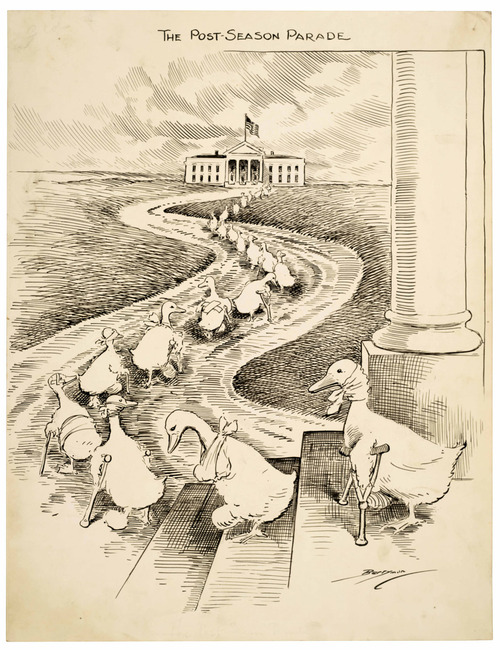




 127
127



